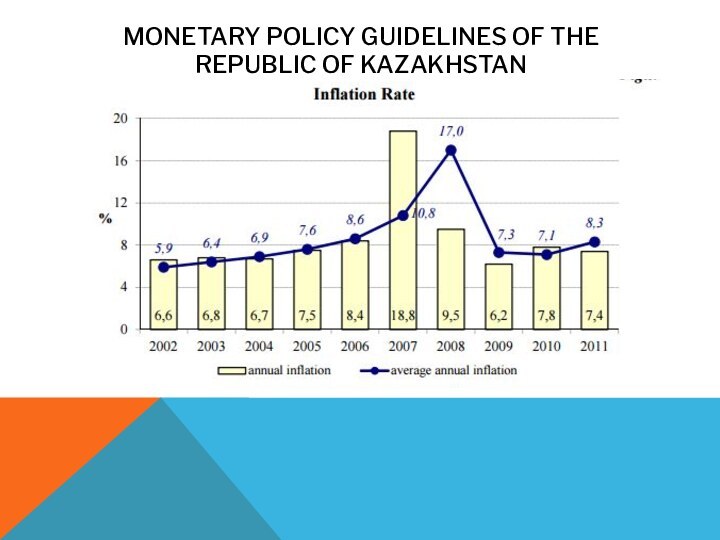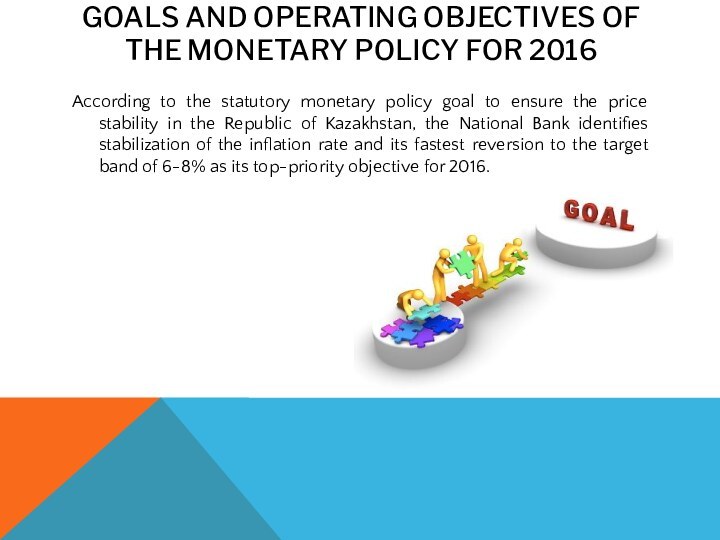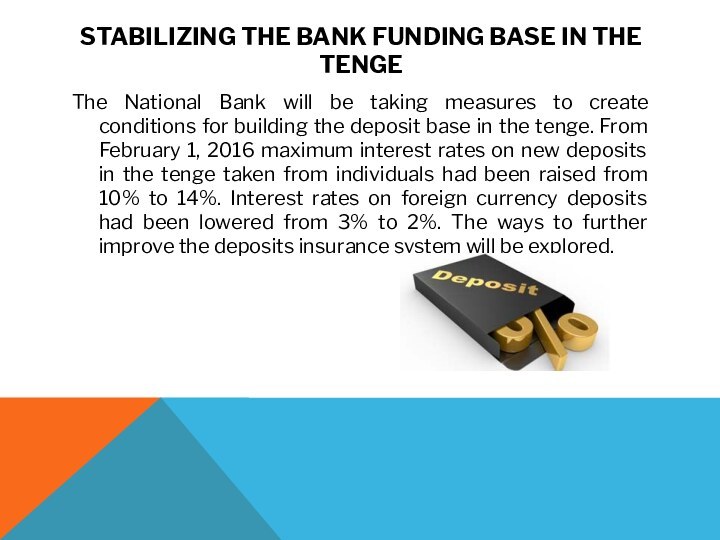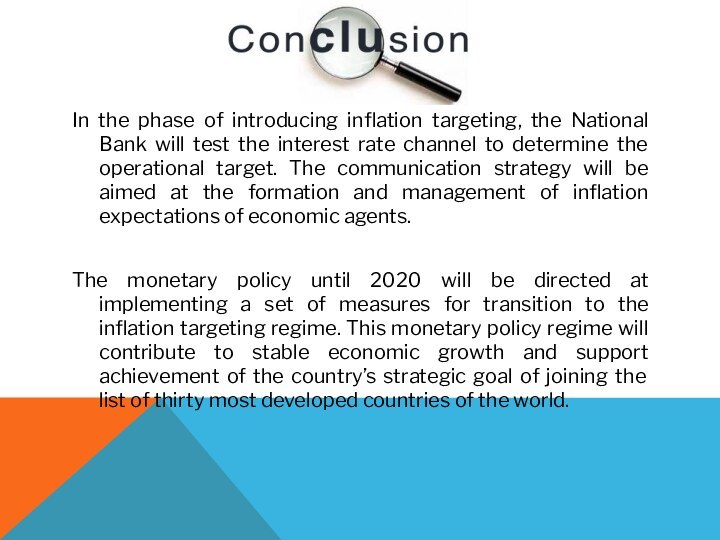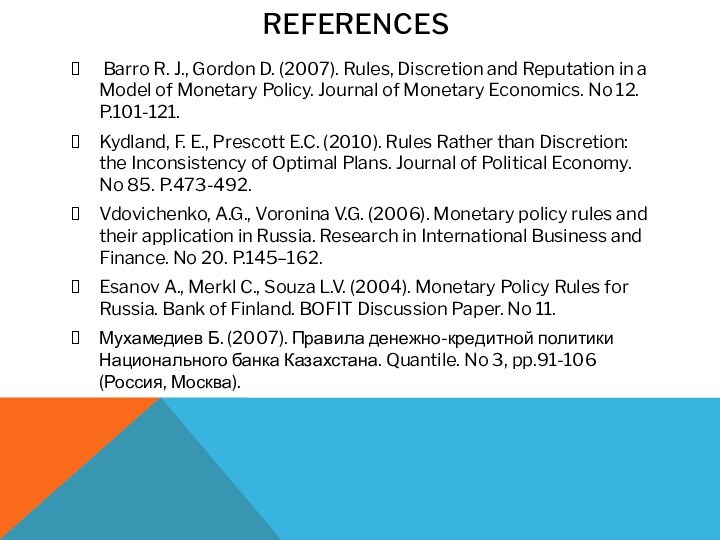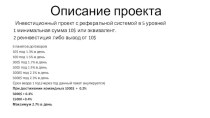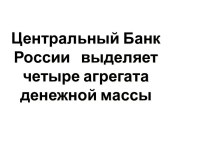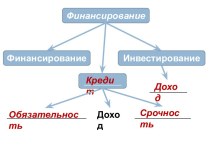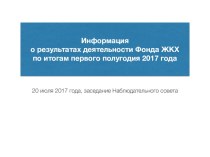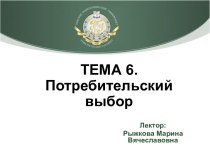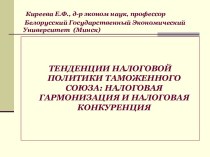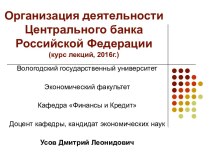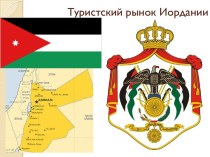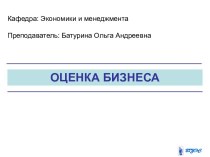Слайд 2
OUTLINE:
MONETARY POLICY GUIDELINES OF THE REPUBLIC OF
KAZAKHSTAN FOR 2016
MACROECONOMIC DEVELOPMENT AND THE MONETARY POLICY OF
THE REPUBLIC OF KAZAKHSTAN IN 2015
GOALS AND OPERATING OBJECTIVES OF THE MONETARY POLICY FOR 2016
MONETARY POLICY INSTRUMENTS
MAIN OBJECTIVES IN THE AREA OF MONETARY POLICY FOR 2016
CONCLUSION
REFERENCES
Слайд 3
MONETARY POLICY GUIDELINES OF THE REPUBLIC OF KAZAKHSTAN
FOR 2016
The main objective of the National Bank of
the Republic of Kazakhstan and its monetary policy pursuant to the Law of the Republic of Kazakhstan “On the National Bank of the Republic of Kazakhstan” dated March 30, 1995, is to ensure the price stability in the country.
In August 2015 the National Bank adopted the inflation targeting regime as a monetary policy regime preferable for Kazakhstan and introduced free floating exchange rate regime for the domestic currency – the tenge.
Слайд 4
MONETARY POLICY GUIDELINES OF THE REPUBLIC OF KAZAKHSTAN
Слайд 5
MONETARY POLICY GUIDELINES OF THE REPUBLIC OF KAZAKHSTAN
Слайд 6
MACROECONOMIC DEVELOPMENT AND THE MONETARY POLICY OF THE
REPUBLIC OF KAZAKHSTAN IN 2015
Significant slowdown in the real
GDP growth rate from 4.1% in 2014 to 1.2% in 2015 was a consequence of negative external impact on Kazakhstan’s economy.
Слайд 7
MACROECONOMIC DEVELOPMENT AND THE MONETARY POLICY OF THE
REPUBLIC OF KAZAKHSTAN IN 2015
In September 2015, inflationary pressures
in the economy increased. Major price growth occurred in October-December 2015, when inflation accounted for 10.4% (over 76% of the overall price growth during 2015). The main factor in dramatic inflation surge was a considerable depreciation of the tenge. Therefore, in 2015 the largest increase occurred in prices for non-food products – by 22.6%, whereas foodstuffs and paid services increased in terms of price by 10.9% and 8.1%, respectively.
Слайд 8
GOALS AND OPERATING OBJECTIVES OF THE MONETARY POLICY
FOR 2016
According to the statutory monetary policy goal to
ensure the price stability in the Republic of Kazakhstan, the National Bank identifies stabilization of the inflation rate and its fastest reversion to the target band of 6-8% as its top-priority objective for 2016.
Слайд 9
MONETARY POLICY INSTRUMENTS
System of Monetary Policy Instruments
of the National Bank
Слайд 10
MAIN OBJECTIVES IN THE AREA OF MONETARY POLICY
FOR 2016
Implementation of the following objectives will help achieving
the goals set by the National Bank, applying monetary policy instruments in an effective way, increasing the strength of the domestic currency as well as ensuring the country’s financial sector stability in 2016:
Managing expectations
Supporting credits to the economy
Stabilizing the bank funding base in the tenge
Developing the interbank market
Слайд 11
MANAGING EXPECTATIONS
The National Bank will be implementing active
communication policy and a policy of transparency in respect
of its actions, including with regard to the prospects of interest rate movements, by building a dialogue with the mass media, business community and the general public.
Слайд 12
SUPPORTING CREDITS TO THE ECONOMY
The main objective for
2016 in supporting the credit market is to take
measures that would not result in the credit market shrinkage but would allow disbursing new loans to enterprises and supporting the real sector.
Слайд 13
STABILIZING THE BANK FUNDING BASE IN THE TENGE
The
National Bank will be taking measures to create conditions
for building the deposit base in the tenge. From February 1, 2016 maximum interest rates on new deposits in the tenge taken from individuals had been raised from 10% to 14%. Interest rates on foreign currency deposits had been lowered from 3% to 2%. The ways to further improve the deposits insurance system will be explored.
Слайд 14
DEVELOPING THE INTERBANK MARKET
Given the fact that the
National Bank will be covering the systemic liquidity gap
with open market operations and interest rates on the standing facilities are penalty rates i.e. they exceed the level of existing market rates, the interbank market should play an important role in redistribution of liquidity.
Слайд 15
CONCLUSION
In the phase of introducing inflation targeting, the
National Bank will test the interest rate channel to
determine the operational target. The communication strategy will be aimed at the formation and management of inflation expectations of economic agents.
The monetary policy until 2020 will be directed at implementing a set of measures for transition to the inflation targeting regime. This monetary policy regime will contribute to stable economic growth and support achievement of the country’s strategic goal of joining the list of thirty most developed countries of the world.




